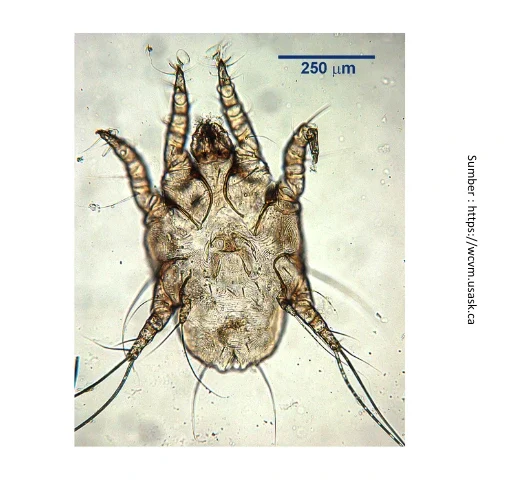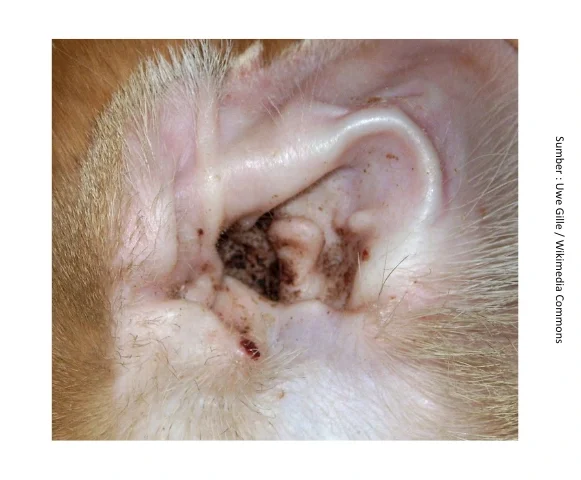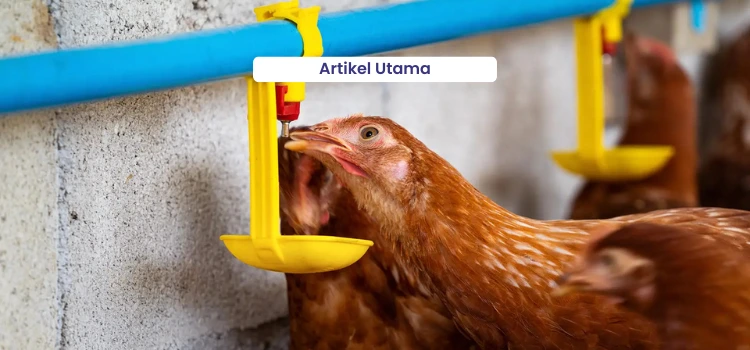Does your cat often scratch its ears? Don’t ignore this condition for too long, as it can cause wounds and ear infections. There are many factors that make cats frequently scratch their ears, one of which is the presence of small parasites inside the ear. These tiny parasites not only cause itching but also make your cat’s inner ears stay dirty even after regular cleaning. While these parasites are not life-threatening, they can cause significant discomfort and are easily transmitted to other cats. Therefore, it’s important to identify the cause and take proper action if your cat is frequently scratching its ears.

Ear Mites (Otodectes cynotis): Tiny Parasites Inside the Ear
The small parasites most commonly found inside a cat’s ear are ear mites, specifically Otodectes cynotis. Ear mites are a type of tiny ectoparasite that can be seen under a microscope. They live on the surface of the skin and feed on earwax, skin oils, and tissue within the ear canal. The life cycle and reproduction process of ear mites are relatively fast. Their eggs take about four days to hatch, and within three weeks, they develop into adult mites ready to reproduce.

Ear mites can be found in cats of all ages, but they are more common and pose a greater risk to kittens. Cats that roam outdoors are also more prone to ear mite infestations, especially when their immune systems are weakened or when they are under stress. Transmission can easily occur between cats through direct contact or indirectly via contaminated objects such as grooming tools that carry mites.
Symptoms of Ear Mites in Cats
Ear mite infestations can occur in one or both of a cat’s ears. The following are several signs that may indicate the presence of mites inside your cat’s ears:
- Itchiness in the ears, causing the cat to frequently scratch them
- Frequent head shaking
- Presence of dark ear discharge that persists even after regular cleaning. The discharge often resembles dry coffee grounds, which is a mixture of dried blood, mite debris, and earwax.
- Unpleasant odor coming from the ears
- Inflammation in the ears (redness and swelling)
- Hair loss and wounds around the ears caused by excessive scratching

Cats showing these symptoms should be further examined to confirm the presence of ear mites. This examination needs to be performed at a veterinary clinic using microscopic observation. The veterinarian will collect an earwax sample with a cotton bud, and the sample will then be examined under a microscope.
Treatment and Prevention of Ear Mites in Cats
– Treatment
Kucing yang sudah diketahui terdapat tungau di saluran telinganya perlu segera dilakukan penanganan supaya tidak semakin parah atau pun tidak menular ke kucing lain. Berikut ini penanganan yang dapat dilakukan :
- Bersihkan saluran telinga kucing dari kotoran supaya obat yang diberikan dapat bekerja dengan maksimal.
- Teteskan seperti M-Otic ke dalam saluran telinga kucing masing-masing sebanyak dua tetes untuk telinga kanan dan kiri. Lakukan pengulangan pada dua minggu berikutnya. M-Otic merupakan obat tetes telinga yang efektif membasmi tungau pada saluran telinga hewan kesayangan. M-Otic sudah teregistrasi di Kementrian Pertanian RI sehingga terjamin baik keamanan, kualitas dan efektivitasnya dalam mengatasi tungau telinga.
- Apabila terdapat gejala peradangan seperti bengkak yang cukup parah, segera periksakan ke dokter hewan.
– Pencegahan
Prevention measures that can be taken to keep cats free from ear mites include:
- Pet cats should not be allowed to roam outside. Provide an adequate play area within the home.
- Apply topical or spot-on anti-ectoparasitic medication (Endtick / Golden Pet Anti Flea & Tick for Cats) regularly every month.
- Maintain ear hygiene by cleaning your cat’s ear canals weekly using a cotton bud or cotton pad.
- Maintain the cleanliness of the environment, cage, and commonly used equipment to prevent mite contamination.
- If a cat shows symptoms of ear mite infestation, immediately place it in a separate cage from other cats to prevent transmission.
Ear mites (Otodectes cynotis) can cause significant discomfort for cats. Although they are not fatal, if left untreated, they can lead to secondary infections that worsen the condition. Immediate treatment and preventive measures should be taken to keep cats free from ear mites.










